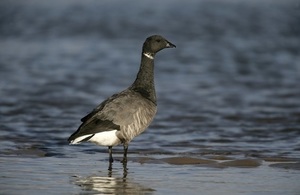Expansion of wildlife protection sites in Essex
The designations in the estuaries of the Crouch and Roach in Essex have been expanded to include new land – increasing protections for wildlife.

Dark-bellied brent goose (Credit: Getty Images)
Two important sites for waterfowl in Essex have been afforded the strongest environmental protections available.
Allfleet’s Marsh and Brandy Hole, part of the Crouch and Roach estuaries, have now been made Special Protection Areas (SPA), Sites of Special Scientific Interest (SSSI) and designated as a Ramsar wetland of international importance.
Environment Minister, Thérèse Coffey said:
This is fantastic news for wildlife and the local community. The designation of this additional land into the existing protected area demonstrates that our management and stewardship of important wildlife habitats is achieving a high standard. We have committed to developing a Nature Recovery Network to protect and restore wildlife in our 25 Year Environment Plan. Through these plans we will be the first generation to leave the environment in a better state than we found it.
Both sites are now functioning as part of the Crouch & Roach Estuaries system. They support intertidal mudflats and developing saltmarsh and provide suitable habitat for the internationally important wintering water birds such as dark-bellied brent geese, lapwing, shoveler and golden plover amongst many other waterfowl species.
The Crouch and Roach Estuaries are an integral part of a continuous network of designated coastal habitats extending north from the Thames Estuary to the Colne Estuary, known as the Mid-Essex Coast.
Kate Jennings, Head of Site Conservation Policy, RSPB said:
The Essex coast used to be a place full of amazing and abundant wildlife, but over the last 400 years, land claim for agriculture, coastal erosion and rising sea levels have taken their toll. The extended designation recognises the importance of new mudflats and saltmarsh created to offset past losses, and is a major step towards restoring this spectacular place. The designation, protection and management of our finest and most valuable places for wildlife will be key in achieving this Government’s 25 Year Environment Plan, and this designation is particularly welcome as it will protect areas immediately adjacent to the RSPB’s Wallasea Island Wild Coast project, where we are working with partners including Defra and the Environment Agency to create more coastal habitat for people and nature.
Approximately 95 per cent of the area of our Sites of Special Scientific Interest and about 60 per cent of the total area of our most important or ‘priority’ wildlife habitats is now in good condition for wildlife or has management in place to restore its condition.
Since 2011 we have established management on approximately 130,000 hectares of land to create new wildlife-rich habitat in the wider countryside.